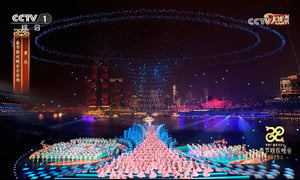Certainly, not many shows in the world can claim to have attracted an impressive 1.5 billion people, but the Spring Festival Gala, produced by CCTV, continuously stands as one of the most-watched television events in the world.
For over three decades, Spring Gala Festival has been a must-watch program for Chinese families celebrating Lunar New Year's Eve and features mix of performances, from music, comedy and traditional arts like opera and martial arts to spectacular acts such as magic and acrobatics. This more than 4-hour-long live broadcast is more than just a television show: it is a display of Chinese cultural heritage and listed on an exclusive UNESCO's Representative List of the Intangible Cultural Heritage of Humanity.
In 2025, it was also the fourth-year viewers could watch the gala on vertical screens. The mobile-optimized vertical format of the gala has proved especially popular, garnering 130 million, 190 million, and 420 million views, respectively, in the three preceding years.
Challenge
Despite its long-standing popularity, the CCTV production team does not rest on laurels and continuously experiments with both innovative content and technology to engage younger audiences. 2025 Spring Gala was no exception. To create fresh visual experiences that would surprise, and delight their audience, CCTV team incorporated Pixotope Fly - drone camera tracking technology - into their production pipeline for the first time.
CCTV implemented Pixotope Fly to create visually hyper-realistic aerial augmented reality effects at 5 broadcast locations: CCTV Headquarters plus remote sites in Chongqing, Wuxi, Lasa, and Wuhan - requiring seamless technical integration across all venues.
Capturing aerial footage after dark introduced significant tracking difficulties, while the pressure of a live broadcast with hundreds of millions of simultaneous viewers left zero margin for error in the real-time implementation. Successfully executing complex augmented reality elements required precise coordination between drone pilots, graphics teams, and production staff. Adding to these challenges, the team had just one month to prepare the entire virtual production workflow.
Solution
The implementation process began with extensive location scouting, as the team worked with CCTV to identify optimal drone flight paths and shooting angles. They established a collaborative workflow, drawing on experience from previous regional deployments at Hunan and Guangdong provincial TV stations. The technical core of the solution utilized Pixotope Fly's advanced computer vision algorithms to enable stable tracking even in challenging nighttime conditions. The team then created location-specific augmented reality elements that complemented the cultural significance of each broadcast site, particularly focusing on the Chongqing and Wuxi segments. Comprehensive rehearsals ensured frame-accurate synchronization between physical camera movements and virtual graphics.
Pixotope Fly solved the tracking challenges through its advanced AI-driven solution that required no additional tracking hardware on the drone, maintained accurate positioning data in low-light conditions, delivered stable camera tracking for real-time graphics compositing, and enabled effortless integration into CCTV's existing broadcast infrastructure.
Benefits
The implementation of Pixotope Fly delivered transformative results for the 2025 Spring Festival Gala. From a creative perspective, it introduced previously impossible aerial viewing angles that expanded the visual language of the production. Aerial augmented reality elements created deeper emotional connections with viewers while delivering new visual experiences that distinguished the 2025 Gala from previous years. The technology elevated the production value to match the high standards expected of China's premier cultural broadcast event. Technical advantages included reliable performance that maintained stable tracking throughout all live broadcast segments. The solution offered operational flexibility, adapting to the specific requirements of each broadcast location while effortlessly integrating within existing production pipelines without disrupting established processes.
The audience impact was substantial, contributing to record viewership across traditional and vertical screen formats. Augmented reality elements amplified the cultural significance of each location and created memorable moments that resonated with audiences worldwide. The vertical format of the gala proved especially popular, continuing its trend of exponential growth in viewership year over year.

